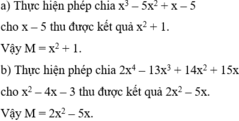

a)
x...">
Hãy nhập câu hỏi của bạn vào đây, nếu là tài khoản VIP, bạn sẽ được ưu tiên trả lời. Bài 2: a, \(A=3x\left(2x-5y\right)+\left(3x-y\right)\left(-2x\right)-\dfrac{1}{2}\left(2-26xy\right)\) \(=6x^2-15xy-6x^2+2xy-1+13xy\) \(=-1\) \(\Rightarrowđpcm\) b, \(B=\left(2x-3\right)\left(4x+1\right)-4\left(x-1\right)\left(2x-1\right)-2x+5\) \(=8x^2+2x-12x-3-4\left(2x^2-x-2x+1\right)-2x+5\) \(=8x^2-10x+2-8x^2+4x+8x-4-2x\) \(=2-4=-2\) \(\Rightarrowđpcm\) a, \(B=\left(\frac{9-3x}{x^2+4x-5}-\frac{x+5}{1-x}-\frac{x+1}{x+5}\right):\frac{7x-14}{x^2-1}\) \(=\left(\frac{9-3x}{\left(x-1\right)\left(x+5\right)}+\frac{\left(x+5\right)^2}{\left(x-1\right)\left(x+5\right)}-\frac{\left(x-1\right)\left(x+1\right)}{\left(x-1\right)\left(x+5\right)}\right):\frac{7\left(x-2\right)}{\left(x-1\right)\left(x+1\right)}\) \(=\frac{9-3x+x^2+10x+25-x^2+1}{\left(x-1\right)\left(x+5\right)}.\frac{\left(x-1\right)\left(x+1\right)}{7\left(x-2\right)}\) \(=\frac{35+7x}{x+5}\frac{x+1}{7\left(x-2\right)}=\frac{7\left(x+5\right)\left(x+1\right)}{7\left(x+5\right)\left(x-2\right)}=\frac{x+1}{x-2}\) b, Ta có : \(\left(x+5\right)^2-9x-45=0\) \(\Leftrightarrow x^2+10x+25-9x-45=0\Leftrightarrow x^2+x-20=0\) \(\Leftrightarrow\left(x-4\right)\left(x-5\right)=0\Leftrightarrow\orbr{\begin{cases}x=4\\x=5\end{cases}}\) TH1 : Thay x = 4 vào biểu thức ta được : \(\frac{4+1}{4-2}=\frac{5}{2}\) TH2 : THay x = 5 vào biểu thức ta được : \(\frac{5+1}{5-2}=\frac{6}{3}=2\) c, Để B nhận giá trị nguyên khi \(\frac{x+1}{x-2}\inℤ\Rightarrow x-2+3⋮x-2\) \(\Leftrightarrow3⋮x-2\Rightarrow x-2\inƯ\left(3\right)=\left\{\pm1;\pm3\right\}\) d, Ta có : \(B=-\frac{3}{4}\Rightarrow\frac{x+1}{x-2}=-\frac{3}{4}\)ĐK : \(x\ne2\) \(\Rightarrow4x+4=-3x+6\Leftrightarrow7x=2\Leftrightarrow x=\frac{2}{7}\)( tmđk ) e, Ta có B < 0 hay \(\frac{x+1}{x-2}< 0\) TH1 : \(\hept{\begin{cases}x+1< 0\\x-2>0\end{cases}\Rightarrow\hept{\begin{cases}x< -1\\x>2\end{cases}}}\)( ktm ) TH2 : \(\hept{\begin{cases}x+1>0\\x-2< 0\end{cases}}\Rightarrow\hept{\begin{cases}x>-1\\x< 2\end{cases}\Rightarrow-1< x< 2}\) a: \(\Leftrightarrow x^2+x+4x+4+m-4⋮x+1\) =>m-4=0 hay m=4 b: \(\Leftrightarrow2x^2+4x-x-2+m+2⋮x+2\) =>m+2=0 hay m=-2 c: \(\Leftrightarrow x^4-x^3+5x^2+x^2-x+5+m-5⋮x^2-x+5\) =>m-5=0 hay m=5 \(1.x^2-4x+4=8\left(x-2\right)^5\) \(\Leftrightarrow\left(x-2\right)^2-8\left(x-2\right)^5=0\) \(\Leftrightarrow\left(x-2\right)^2\left[1-8\left(x-2\right)^3\right]=0\) \(\Leftrightarrow\orbr{\begin{cases}\left(x-2\right)^2=0\\1-8\left(x-2\right)^3=0\end{cases}}\) \(\Leftrightarrow\orbr{\begin{cases}x=2\\\left(x-2\right)^3=\frac{1}{8}\end{cases}\Rightarrow\orbr{\begin{cases}x=2\\x=\frac{5}{2}\end{cases}}}\) \(T=4\left(a^3+b^3\right)-6\left(a^2+b^2\right)\) \(=4\left(a+b\right)\left(a^2-ab+b^2\right)-6a^2-6b^2\) \(=4\left(a^2-ab+b^2\right)-6a^2-6b^2\)(Vì a+b=1) \(=4a^2-4ab+3b^2-6a^2-6b^2\) \(=-2a^2-4ab-2b^2\) \(=-2\left(a+b\right)^2=-2\) \(x^8+x^4+1\) \(=\left(x^8+2x^4+1\right)-x^4\) \(=\left(x^4+1\right)^2-x^4\) \(=\left(x^4+1-x^2\right)\left(x^4+1+x^2\right)\) \(=\left(x^4-x^2+1\right)\left(x^4+2x^2-x^2+1\right)\) \(=\left(x^4-x^2+1\right)[\left(x^2+1\right)^2-x^2]\) \(=\left(x^4-x^2+1\right)\left(x^2+1-x\right)\left(x^2+1+x\right)\) Câu 1: a: =(y-3)(x^2-16) =(x-4)(x+4)(y-3) b: \(=\left(2x+1\right)^2-y^2\) \(=\left(2x+1+y\right)\left(2x+1-y\right)\) 1) \(\dfrac{A\left(x-5\right)}{\left(x+1\right)\left(x-5\right)}=\dfrac{3x\left(x+3\right)}{\left(x+1\right)\left(x+3\right)}\) \(\Rightarrow A=3x\) 2) \(\dfrac{\left(x+3\right)\left(x-2\right)}{A\left(x-3\right)}=\dfrac{\left(5x-1\right)\left(x-2\right)}{\left(5x-1\right)\left(x^2+3\right)}\) \(\Leftrightarrow\dfrac{\left(x+3\right)}{A\left(x-3\right)}=\dfrac{1}{\left(x^2+3\right)}\) \(\Rightarrow A=\dfrac{\left(x^2+3\right)\left(x+3\right)}{x-3}\) 3) \(\dfrac{\left(x-5\right)\left(x+5\right)}{\left(x+5\right)\left(2x-3\right)}=\dfrac{\left(x-5\right)A}{\left(2x-3\right)\left(x+2\right)}\) \(\Leftrightarrow1=\dfrac{A}{\left(x+2\right)}\) \(\Leftrightarrow A=x+2\) Vì dài quá nên mình chỉ có thể trả lời được mấy câu thôi Bài 1: 27x3 - 8 : (6x + 9x2 +4) = (3x - 2) (9x2 + 6x + 4) : (9x2 + 6x + 4) = 3x - 2 Bài 3: a, 81x4 + 4 = (9x2)2 + 36x2 + 4 - 36x2 = (9x2 + 2)2 - (6x)2 = (9x2 + 6x + 2)(9x2 - 6x + 2) b, x2 + 8x + 15 = x2 + 3x + 5x + 15 = x(x + 3) + 5(x + 3) = (x + 3)(x + 5) c, x2 - x - 12 = x2 + 3x - 4x - 12 = x(x + 3) - 4(x + 3) = (x + 3) (x - 4) Câu 1: (27x3 - 8) : (6x + 9x2 + 4) = (3x - 2)(9x2 + 6x + 4) : (6x + 9x2 + 4) = 3x - 2 Câu 2: a) (3x - 5)(2x+ 11) - (2x + 3)(3x + 7) = 6x2 + 33x - 10x - 55 - 6x2 - 14x - 9x - 21 = -76 ⇒ đccm b) (2x + 3)(4x2 - 6x + 9) - 2(4x3 - 1) = 8x3 + 27 - 8x3 + 2 = 29 ⇒ đccm Câu 3: a) 81x4 + 4 = (9x2)2 + 22 = (9x2 + 2)2 - (6x)2 = (9x2 - 6x + 2)(9x2 + 6x + 2) b) x2 + 8x + 15 = x2 + 3x + 5x + 15 = x(x + 3) + 5(x + 3) = (x + 3)(x + 5) c) x2 - x - 12 = x2 - 4x + 3x - 12 = x(x - 4) + 3(x - 4) = (x - 4)(x + 3) bài 1: b,\(\dfrac{x+2}{x}=\dfrac{x^2+5x+4}{x^2+2x}+\dfrac{x}{x+2}\)(ĐKXĐ:x ≠0,x≠-2) <=>\(\dfrac{\left(x+2\right)^2}{x\left(x+2\right)}=\dfrac{x^2+5x+4}{x\left(x+2\right)}+\dfrac{x^2}{x\left(x+2\right)}\) =>\(x^2+4x+4=x^2+5x+4+x^2\) <=>\(x^2-x^2-x^2+4x-5x+4-4=0\) <=>\(-x^2-x=0< =>-x\left(x+1\right)=0< =>\left[{}\begin{matrix}x=0\left(loại\right)\\x+1=0< =>x=-1\left(nhận\right)\end{matrix}\right.\) vậy............... d,\(\left(x+3\right)^2-25=0< =>\left(x+3-5\right)\left(x+3+5\right)=0< =>\left(x-2\right)\left(x+8\right)=0< =>\left[{}\begin{matrix}x-2=0\\x+8=0\end{matrix}\right.< =>\left[{}\begin{matrix}x=2\\x=-8\end{matrix}\right.\) vậy............ bài 3: g,\(\dfrac{4}{x+1}-\dfrac{2}{x-2}=\dfrac{x+3}{x^2-x-2}\)(ĐKXĐ:x khác -1,x khác 2) <=>\(\dfrac{4}{x+1}-\dfrac{2}{x-2}=\dfrac{x+3}{x^2-2x+x-2}\) <=>\(\dfrac{4}{x+1}-\dfrac{2}{x-2}=\dfrac{x+3}{x\left(x-2\right)+\left(x-2\right)}\) <=>\(\dfrac{4}{x+1}-\dfrac{2}{x-2}=\dfrac{x+3}{\left(x+1\right)\left(x-2\right)}\) <=>\(\dfrac{4\left(x-2\right)}{\left(x+1\right)\left(x-2\right)}-\dfrac{2\left(x+1\right)}{\left(x+1\right)\left(x-2\right)}=\dfrac{x+3}{\left(x+1\right)\left(x-2\right)}\) =>\(4x-8-2x-2=x+3\) <=>\(x=13\) vậy.............. mấy ý khác bạn làm tương tụ nhé chúc bạn học tốt ^ ^ Bài 1. a)\(\frac{4x-4}{x^2-4x+4}\div\frac{x^2-1}{\left(2-x\right)^2}=\frac{4\left(x-1\right)}{\left(x-2\right)^2}\div\frac{\left(x-1\right)\left(x+1\right)}{\left(x-2\right)^2}=\frac{4\left(x-1\right)}{\left(x-2\right)^2}\times\frac{\left(x-2\right)^2}{\left(x-1\right)\left(x+1\right)}=\frac{4}{x+1}\) b) \(\frac{2x+1}{2x^2-x}+\frac{32x^2}{1-4x^2}+\frac{1-2x}{2x^2+x}=\frac{2x+1}{x\left(2x-1\right)}+\frac{-32x^2}{4x^2-1}+\frac{1-2x}{x\left(2x+1\right)}\) \(=\frac{\left(2x+1\right)\left(2x+1\right)}{x\left(2x-1\right)\left(2x+1\right)}+\frac{-32x^3}{x\left(2x-1\right)\left(2x+1\right)}+\frac{\left(1-2x\right)\left(2x-1\right)}{x\left(2x-1\right)\left(2x+1\right)}\) \(=\frac{4x^2+4x+1}{x\left(2x-1\right)\left(2x+1\right)}+\frac{-32x^3}{x\left(2x-1\right)\left(2x+1\right)}+\frac{-4x^2+4x-1}{x\left(2x-1\right)\left(2x+1\right)}\) \(=\frac{4x^2+4x+1-32x^3-4x^2+4x-1}{x\left(2x-1\right)\left(2x+1\right)}=\frac{-32x^3+8x}{x\left(2x-1\right)\left(2x+1\right)}\) \(=\frac{-8x\left(4x^2-1\right)}{x\left(2x-1\right)\left(2x+1\right)}=\frac{-8x\left(2x-1\right)\left(2x+1\right)}{x\left(2x-1\right)\left(2x+1\right)}=-8\) c) \(\left(\frac{1}{x+1}+\frac{1}{x-1}-\frac{2x}{1-x^2}\right)\times\frac{x-1}{4x}\) \(=\left(\frac{1}{x+1}+\frac{1}{x-1}+\frac{2x}{x^2-1}\right)\times\frac{x-1}{4x}\) \(=\left(\frac{x-1}{\left(x-1\right)\left(x+1\right)}+\frac{x+1}{\left(x-1\right)\left(x+1\right)}+\frac{2x}{\left(x-1\right)\left(x+1\right)}\right)\times\frac{x-1}{4x}\) \(=\left(\frac{x-1+x+1+2x}{\left(x-1\right)\left(x+1\right)}\right)\times\frac{x-1}{4x}\) \(=\frac{4x}{\left(x-1\right)\left(x+1\right)}\times\frac{x-1}{4x}=\frac{1}{x+1}\) Bài 3. N = ( 4x + 3 )2 - 2x( x + 6 ) - 5( x - 2 )( x + 2 ) = 16x2 + 24x + 9 - 2x2 - 12x - 5( x2 - 4 ) = 14x2 + 12x + 9 - 5x2 + 20 = 9x2 + 12x + 29 = 9( x2 + 4/3x + 4/9 ) + 25 = 9( x + 2/3 )2 + 25 ≥ 25 > 0 ∀ x => đpcm



x - 2 1 -1 3 -3 x 3 1 5 -1 






